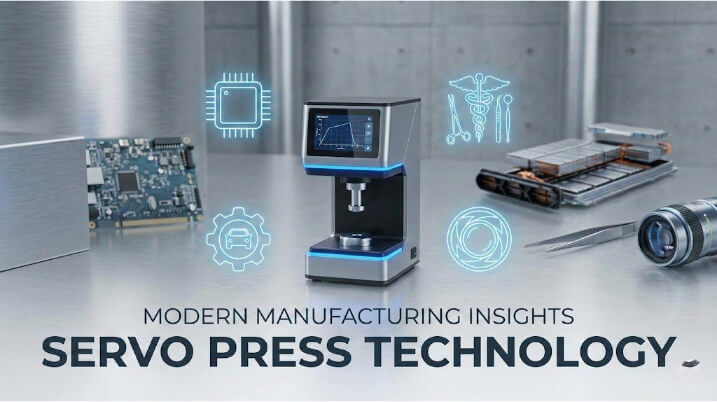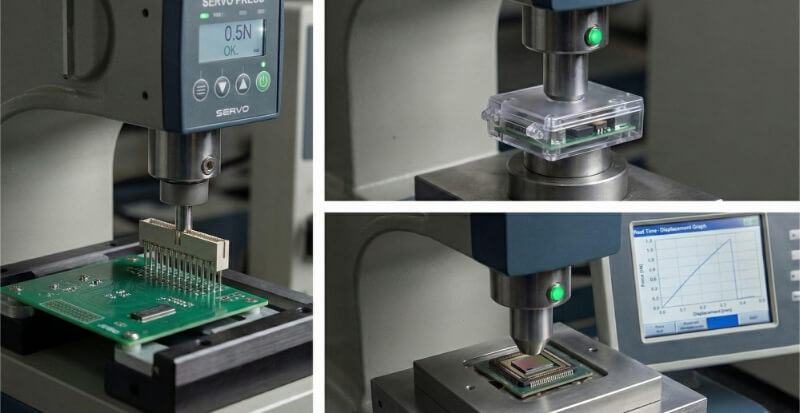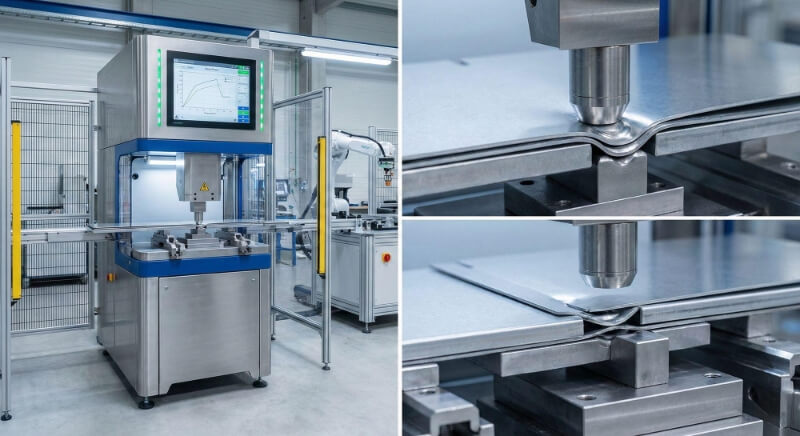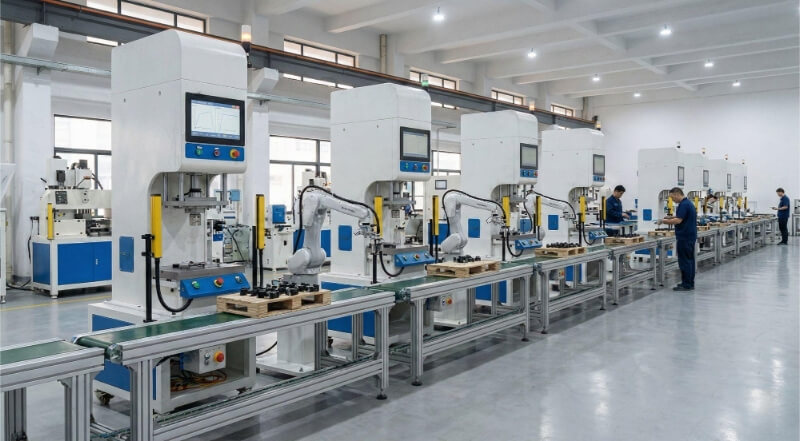يمكن أن يؤدي اختيار المعدن إلى نجاح مشروعك أو فشله. اختر المعدن الخاطئ، وعليك تجنب الأخطاء المكلفة والنتائج دون المستوى. ولكن اختر المعدن المناسب، وستفتح لك عالماً من الإمكانيات. الألومنيوم والصلب خياران شائعان، ولكل منهما نقاط قوة فريدة. فأيهما يجب أن تستخدم؟
ويتألق الألومنيوم في التطبيقات خفيفة الوزن ومقاومة التآكل، بينما يتفوق الفولاذ في القوة وفعالية التكلفة. لكلا المعدنين مكانتهما في التصنيع والتصميم الحديث. يعتمد اختيارك على احتياجات مشروعك وقيود الميزانية ومتطلبات الأداء.
دعنا نستكشف الاختلافات الرئيسية بين الألومنيوم والفولاذ. سوف نقارن بين خصائصهما وتطبيقاتهما وإيجابياتهما وسلبياتهما لمساعدتك في اتخاذ قرار بشأن مشروعك القادم.
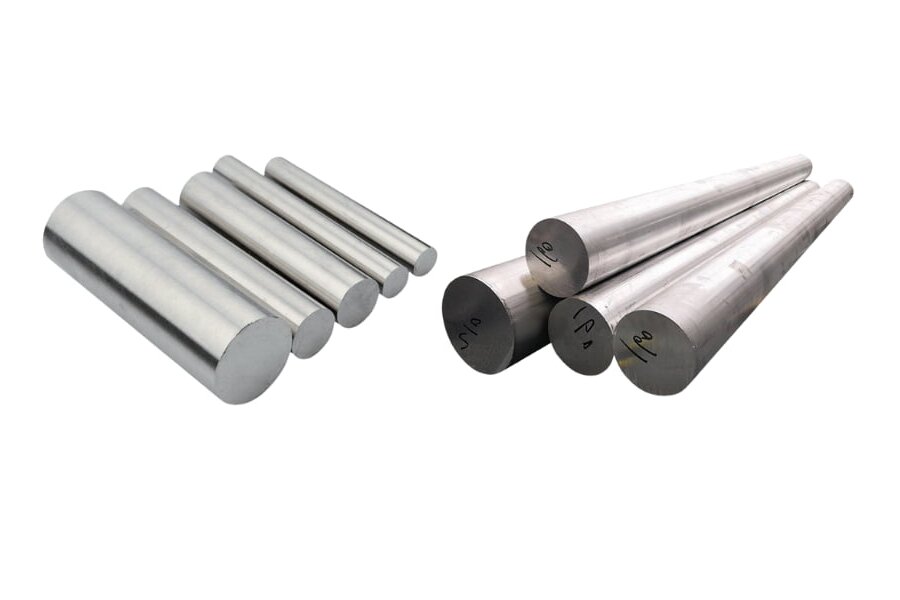
الألومنيوم مقابل الفولاذ: فهم الأساسيات
الألومنيوم: خصائصه وتكوينه ومزاياه
الألومنيوم معدن أبيض فضي خفيف الوزن. وهو ثالث أكثر العناصر وفرة في القشرة الأرضية. نستخرجه من خام البوكسيت من خلال عملية تسمى التحليل الكهربائي. تفصل هذه الطريقة الألومنيوم عن ذرات الأكسجين في الخام.
يتميز الألومنيوم بالعديد من الخصائص الحيوية. فهو خفيف الوزن، حيث تبلغ كثافته حوالي ثلث كثافة الفولاذ. وهذا يجعله مثاليًا للاستخدامات التي يكون فيها الوزن مهمًا. كما يقاوم المعدن التآكل بشكل جيد. فعند تعريضه للهواء، يشكل طبقة رقيقة من الأكسيد تحمي المعدن الأساسي.
تشمل المزايا الأخرى للألومنيوم موصلية حرارية وكهربائية عالية. كما أنه غير مغناطيسي وغير سام. وهذه الخصائص تجعله متعدد الاستخدامات في مختلف الصناعات.
الفولاذ: خواصه وتشكيله ومزاياه
الصلب هو سبيكة من الحديد والكربون. نصنعه عن طريق تسخين خام الحديد في الفرن العالي وإضافة الكربون. تؤثر كمية الكربون على خصائص الصلب. فالمزيد من الكربون يعني عموماً قوة أعلى ولكن مرونة أقل.
الميزة البارزة للصلب هي قوته. فقوته العالية في الشد تجعله مقاومًا للتمدد والكسر. كما يحافظ الفولاذ على قوته في درجات الحرارة العالية أفضل من الألومنيوم.
يوفر الفولاذ قابلية تشكيل ولحام جيدة. وهو سهل التشكيل والتوصيل نسبياً. كما أن هذا المعدن قابل لإعادة التدوير بدرجة كبيرة، وهي ميزة بيئية كبيرة. خصائص الفولاذ المغناطيسية تجعله مفيداً في التطبيقات الكهربائية.
الألومنيوم مقابل الفولاذ: تحليل مقارن
وزن
الوزن عامل حاسم في العديد من القرارات الهندسية والتصميمية. ويحتل الألومنيوم الصدارة هنا. فهو يزن حوالي ثلث وزن الفولاذ لنفس الحجم. وهذا يجعل الألومنيوم الخيار المفضل في صناعات مثل صناعة الطيران والسيارات.
في مجال النقل، تعني المواد الأخف وزناً كفاءة أفضل في استهلاك الوقود. تسمح الكثافة المنخفضة للألومنيوم باستخدام هياكل أكبر دون زيادة مفرطة في الوزن. ولهذا السبب غالباً ما ترى الألومنيوم في هياكل الطائرات وألواح السيارات.
ومع ذلك، فإن الوزن الأعلى للصلب يكون عيباً في بعض الأحيان فقط. فالكتلة الإضافية توفر الثبات والتثبيت في بعض التطبيقات، مثل أساسات المباني أو الآلات الثقيلة.
قوة
عندما يتعلق الأمر بالقوة، فإن الفولاذ هو بطل الوزن الثقيل. فهو يمتاز بقوة شد أعلى من الألومنيوم، مما يجعله يتحمل المزيد من الضغط قبل أن ينكسر. وهذا ما يجعل الفولاذ مثاليًا للهياكل الحاملة للأحمال والتطبيقات عالية الإجهاد.
نسبة قوة الفولاذ إلى الوزن مثيرة للإعجاب. وعلى الرغم من أنه أثقل وزناً، إلا أنه غالباً ما يتطلب مواد أقل لتحقيق نفس السلامة الهيكلية التي يتطلبها الألومنيوم. وهذا يمكن أن يعوض عيب الوزن في بعض السيناريوهات.
الألومنيوم ليس ضعيفاً بأي حال من الأحوال. فالعديد من سبائك الألومنيوم توفر قوة ممتازة بالنسبة لوزنها. ومع ذلك، عادةً ما يكون الفولاذ في المقدمة في الاستخدامات التي تكون فيها القوة المطلقة ذات أهمية قصوى.
تطويع
كل من الألومنيوم والصلب معدنان قابلان للطرق، لكنهما يتصرفان بشكل مختلف. الألومنيوم بشكل عام أكثر مرونة من الفولاذ. فمن الأسهل تشكيل أشكال معقدة دون تشقق أو انكسار. هذه الخاصية تجعل الألومنيوم شائعًا في الصناعات التي تتطلب تصميمات معقدة أو أجزاء رقيقة الجدران.
وعلى الرغم من أن الفولاذ أقل قابلية للطرق من الألومنيوم، إلا أنه لا يزال يوفر قابلية تشكيل جيدة. ويمكن تعديل قابليته للطرق من خلال عناصر السبائك المختلفة والمعالجات الحرارية. تسمح هذه المرونة بتخصيص الفولاذ لعمليات تشكيل محددة.
يمكن أن تكون قابلية الألومنيوم العالية للطرق مفيدة في عمليات التصنيع مثل الختم والبثق. وغالباً ما يتطلب قوة أقل لتشكيله، مما يقلل من تكاليف الأدوات واستهلاك الطاقة.
توصيل حراري
يتفوق الألومنيوم على الفولاذ في التوصيل الحراري. فهو ينقل الحرارة بكفاءة أكبر، مما يجعله خيارًا ممتازًا للمبادلات الحرارية وأنظمة التبريد. هذه الخاصية هي السبب في أنك غالباً ما تجد الألومنيوم في المشعات ووحدات تكييف الهواء.
يمكن أن تكون الموصلية الحرارية المنخفضة للصلب ميزة في بعض السيناريوهات. فهو أفضل في العزل ضد التغيرات في درجات الحرارة. يُعد الفولاذ خيارًا جيدًا للتطبيقات التي ترغب في الحفاظ على درجة حرارة ثابتة، كما هو الحال في تشييد المباني.
في الإلكترونيات، تساعد الموصلية الحرارية العالية للألومنيوم في تبديد الحرارة من المكونات. وهذا أمر بالغ الأهمية لمنع ارتفاع درجة الحرارة في الأجهزة مثل أجهزة الكمبيوتر المحمولة والهواتف الذكية.
المقاومة للتآكل
يتمتع الألومنيوم بميزة طبيعية في مقاومة التآكل. فعند تعريضه للهواء، يكوّن طبقة رقيقة من الأكسيد تحمي المعدن الأساسي. هذه الخاصية ذاتية الالتئام تجعل الألومنيوم شديد المقاومة للصدأ وأشكال التآكل الأخرى.
الصلب، وخاصة الصلب الكربوني، أكثر عرضة للصدأ عند تعرضه للرطوبة والأكسجين. ومع ذلك، فإن الفولاذ المقاوم للصدأ، وهو سبيكة تحتوي على الكروم، يوفر مقاومة ممتازة للتآكل. فهو يشكل طبقة أكسيد الكروم الواقية المشابهة لطبقة أكسيد الألومنيوم.
في البيئات البحرية أو الاستخدامات الخارجية، يمكن أن تؤدي مقاومة الألومنيوم للتآكل إلى انخفاض تكاليف الصيانة وإطالة عمر المنتج. وغالباً ما يتطلب الفولاذ معالجات أو طلاءات إضافية لحماية مماثلة.
يكلف
يفوز الفولاذ بشكل عام في قسم التكلفة. فهو عادةً أرخص من الألومنيوم فيما يتعلق بتكلفة المواد الخام والمعالجة. وهذا يجعل من الفولاذ خياراً جذاباً للمشاريع الكبيرة حيث تكون الميزانية هي الشغل الشاغل.
يمكن تعويض التكلفة الأولية المرتفعة للألومنيوم بانخفاض وزنه ومقاومته الأفضل للتآكل في بعض التطبيقات. وعلى مدى عمر المنتج، قد يكون الألومنيوم أكثر فعالية من حيث التكلفة بسبب انخفاض تكاليف الصيانة والنقل.
يمكن أن يتقلب فرق السعر بين المعدنين بناءً على ظروف السوق وسلاسل التوريد العالمية. من المفيد دائماً التحقق من الأسعار الحالية عند اتخاذ القرار.
مقارنة الخصائص الفيزيائية
دعونا نحلل بعض الخصائص الفيزيائية المهمة:
- الكثافة: الألومنيوم (2.7 جم/سم مكعب) مقابل الفولاذ (7.85 جم/سم مكعب)
- نقطة الانصهار: الألومنيوم (660 درجة مئوية) مقابل الفولاذ (1370-1530 درجة مئوية)
- التوصيل الكهربائي: الألومنيوم (37.7 مليون S/m) مقابل الصلب (6.99 مليون S/m)
- قوة الخضوع: الألومنيوم (7-11 ميجا باسكال) مقابل الفولاذ (250-1000 ميجا باسكال، حسب الدرجة)
تسلط هذه الاختلافات الضوء على سبب أهمية اختيار المواد. فالخصائص الفريدة لكل معدن تجعله مناسبًا لتطبيقات مختلفة.
الألومنيوم مقابل الفولاذ: مقارنة سريعة
إليك مقارنة سريعة بين الألومنيوم والفولاذ في شكل جدول:
| الملكية | الألومنيوم | فُولاَذ |
|---|---|---|
| وزن | أخف وزناً (1/3 وزن الفولاذ) | أثقل |
| قوة | نسبة قوة إلى الوزن جيدة | قوة مطلقة أعلى |
| تطويع | أكثر مرونة | أقل مرونة، ولكنها لا تزال قابلة للتشكيل |
| توصيل حراري | أعلى | أدنى |
| المقاومة للتآكل | ممتاز (يشكل طبقة أكسيد واقية) | يختلف (صدأ الفولاذ الكربوني ومقاومة الفولاذ المقاوم للصدأ) |
| يكلف | أكثر تكلفة بشكل عام | عادةً ما تكون أرخص |
| كثافة | 2.7 جم/سم مكعب | 7.85 جم/سم مكعب |
| نقطة الانصهار | 660°C | 1370-1530°C |
| التوصيل الكهربائي | 37.7 مليون S/متر مربع | 6.99 مليون S/متر مكعب/متر |
| قوة العائد | 7-11 ميجا باسكال | 250-1000 ميجا باسكال (تختلف حسب الدرجة) |
الألومنيوم مقابل الفولاذ: التطبيقات
يتميز كل من الألومنيوم والفولاذ بميزات خاصة للاستخدام في العالم الحقيقي. دعونا نلقي نظرة على المواضع التي يتألق فيها هذان المعدنان حقًا.
يحتل الألومنيوم الصدارة في:
- الفضاء الجوي: خصائصها خفيفة الوزن تجعلها مثالية للطائرات والمركبات الفضائية.
- السيارات: يستخدمه مصنعو السيارات لتقليل وزن السيارة وزيادة كفاءة استهلاك الوقود.
- الالكترونيات: ستجده في أجهزة الكمبيوتر المحمولة والهواتف الذكية والأجهزة المحمولة الأخرى.
- التغليف: فكّر في علب المشروبات وحاويات الطعام.
يهيمن الفولاذ في:
- بناء: إنها العمود الفقري لناطحات السحاب والجسور والبنية التحتية.
- الآلات الثقيلة: تعتمد الحفارات والرافعات والمعدات الصناعية على قوة الفولاذ.
- الأجهزة: تستخدم العديد من الأدوات المنزلية مثل الثلاجات والغسالات الفولاذ.
- أدوات: من مفاتيح الربط إلى الأدوات الكهربائية، فإن الفولاذ هو المادة المفضلة.
لكلا المعدنين مكانتهما في مختلف الصناعات. ويعتمد اختيارك على المتطلبات المحددة لمشروعك.
الألومنيوم مقابل الفولاذ: كيفية اختيار السبيكة المناسبة
يعد اختيار سبيكة مناسبة لمشروعك أمراً بالغ الأهمية. إليك دليل لمساعدتك في الاختيار بين سبائك الألومنيوم والصلب:
حدد متطلبات مشروعك:
- قيود الوزن
- احتياجات القوة
- متطلبات مقاومة التآكل
- قيود الميزانية
- الظروف البيئية
- طرق التصنيع
ضع في اعتبارك سبائك الألومنيوم عند الحاجة إليها:
- حلول خفيفة الوزن (على سبيل المثال، 6061-T6 للاستخدام للأغراض العامة)
- مقاومة ممتازة للتآكل (على سبيل المثال، 5052 للبيئات البحرية)
- نسبة قوة إلى وزن عالية (على سبيل المثال، 7075 للتطبيقات الفضائية)
- توصيل حراري جيد (على سبيل المثال، 1100 للمبادلات الحرارية)
اختر السبائك الفولاذية عند الحاجة:
- قوة عالية (على سبيل المثال، 4140 للآلات الثقيلة)
- فعالية التكلفة (على سبيل المثال، 1018 للاستخدام الهيكلي العام)
- الخواص المغناطيسية (على سبيل المثال، الفولاذ المقاوم للصدأ 430 للتطبيقات المغناطيسية)
- مقاومة الحرارة (على سبيل المثال، الفولاذ المقاوم للصدأ 310 للبيئات ذات درجات الحرارة العالية)
تقييم عملية التصنيع:
- لحام المتطلبات (كلا المعدنين قابلان للحام، ولكن تختلف التقنيات)
- احتياجات التصنيع (الألومنيوم بشكل عام أكثر سهولة في التصنيع الآلي)
- تشكيل التعقيد (الألومنيوم أكثر مرونة)
يعتبر صقل الأسطح الخيارات:
تقييم الصيانة على المدى الطويل:
- مقاومة الألومنيوم الطبيعية للتآكل
- حاجة الفولاذ إلى طلاءات واقية في بعض البيئات
تذكر أن الخيار الأفضل غالبًا ما ينطوي على تنازلات. وازن بين جميع العوامل بعناية للعثور على السبيكة المثلى لاستخدامك المحدد.
خاتمة
لكل من الألومنيوم والفولاذ نقاط قوة وتطبيقات مثالية. يتفوق الألومنيوم في سيناريوهات خفيفة الوزن ومقاومة للتآكل، بينما يتألق الفولاذ في التطبيقات عالية القوة والفعالة من حيث التكلفة. يعتمد اختيارك على احتياجات مشروعك المحددة، والموازنة بين الوزن والقوة والتكلفة والظروف البيئية. يستمر كلا المعدنين في لعب أدوار حاسمة في التصنيع والهندسة الحديثة.
هل تحتاج إلى مصنع موثوق لأجزاء الصفائح المعدنية؟ شنغن هو المكان المناسب للذهاب. نحن متخصصون في قطع الصفائح المعدنية بالليزر، والثني، وتشطيب الأسطح، والتصنيع باستخدام الحاسب الآلي. تواصل مع شنغن اليوم وطلب المساعدة من المتخصصين!
الأسئلة الشائعة
كيف يكون أداء الألومنيوم والصلب في الظروف الجوية القاسية؟
يعمل الألومنيوم بشكل أفضل في البيئات الباردة والساحلية بسبب مقاومته للتآكل. يمكن أن يصبح الفولاذ هشاً في البرودة الشديدة ولكنه يتعامل مع درجات الحرارة العالية بشكل أفضل من الألومنيوم. يمكن معالجة كلا المعدنين أو خلطهما بسبيكة لتحسين أدائهما في الظروف القاسية.
ما الذي يدوم لفترة أطول، الألومنيوم أم الفولاذ؟
يدوم الألومنيوم لفترة أطول في البيئات المسببة للتآكل بسبب طبقة الأكسيد الطبيعية. ومع ذلك، يمكن لأنواع معينة من الفولاذ، مثل الفولاذ المقاوم للصدأ، أن تضاهي أو تتجاوز طول عمر الألومنيوم. ويعتمد العمر الافتراضي لكلا المعدنين بشكل كبير على البيئة المحددة والاستخدام.
هل يتشقق الألومنيوم أسهل من الفولاذ؟
عادةً ما يكون الألومنيوم أكثر عرضة للتشقق الناتج عن الإرهاق من الفولاذ. ومع ذلك، فهو أيضاً أكثر مرونة مما يسمح له بالانحناء دون أن ينكسر. قوة الشد الأعلى للصلب تجعله أكثر مقاومة للتشقق الناتج عن الضغط العالي.
ما مدى قوة الفولاذ مقابل الألومنيوم؟
عادةً ما يكون الفولاذ عادةً أقوى من الألومنيوم من حيث قوة الشد بمقدار 2-3 مرات. ومع ذلك، يمكن أن تكون نسبة قوة الألومنيوم إلى الوزن أعلى من الألومنيوم في بعض التطبيقات. يعتمد الفرق الدقيق في القوة على السبائك المحددة التي تتم مقارنتها.
مهلا، أنا كيفن لي

على مدى السنوات العشر الماضية، كنت منغمسًا في أشكال مختلفة من تصنيع الصفائح المعدنية، وشاركت رؤى رائعة هنا من تجاربي عبر ورش العمل المتنوعة.
ابقى على تواصل

كيفن لي
لدي أكثر من عشر سنوات من الخبرة المهنية في تصنيع الصفائح المعدنية، وتخصصت في القطع بالليزر، والثني، واللحام، وتقنيات معالجة الأسطح. كمدير فني في شنغن، أنا ملتزم بحل تحديات التصنيع المعقدة ودفع الابتكار والجودة في كل مشروع.

